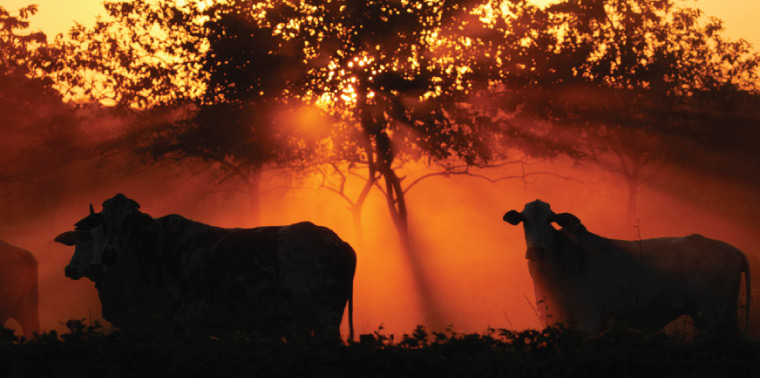February 20, 2013 — As the world’s population grows — to 9 billion by 2050 — so too does the demand for food. That means land currently dedicated to agriculture is being tasked with producing greater yields, often in a shorter amount of time. Researchers around the world are working to figure out how to meet such demand without degrading the environment. With an abundance of natural resources, Brazil is a poster child for this challenge. South America’s largest and most populated state, it holds more renewable freshwater than any other country in the world and is known as home to the “lungs of the Earth” for the innumerable trees that call the 2.1 million square mile Amazon rain forest home.
It is also a nation that has seen its share of conflict between environmentalists and farmers over the use of the country’s forests. In fact, in recent years vocal environmentalists have been gunned down, and some have blamed farmers and ranchers for the deaths.
It is in this context and in the face of the country’s much-criticized Forest Code — which is meant to protect 80 percent of the Amazon forest as legal reserves — that Brazil’s Confederations of Agriculture and Livestock (CNA), a national organization that represents rural farmers, and the Brazilian Agricultural Research Corporation (Embrapa), a state-owned company affiliated with the Ministry of Agriculture, three years ago introduced a plan they believe will please both environmentalists and farmers by allowing for production and preservation.
According to Embrapa and CNA the plan, known as the Biomes Project, will deliver technical and scientific solutions and introduce proven techniques that retain agricultural production as well as promote environmental protection mostly through the use of trees on properties dedicated to agriculture in Brazil’s various biomes: Amazonia, Atlantic Forest, Cerrado, Caatinga, Pampa and Pantanal. Researchers involved with the Biomes Project, which is scheduled to last nine years, say they are showing how trees help the soil and surrounding waterways while specifically identifying the best potential uses for the land in each biome that will also be the most sustainable.
One example is the Biomes Project’s “Farm Days,” which shows farmers how certain soil is ideal for growing trees that can later be used to build fences. But the farmers also learn the importance of having trees on their land in order to keep soil fertile, which therefore increases the land’s productivity, and they are encouraged to always have some trees growing on their property.
“Our results will have a high degree of interaction among environmental, social and economic factors,” says Gustavo Ribas Curcio, a researcher and technical coordinator for the Biomes Project from Embrapa, via email and translated from his native Portuguese. “We have to achieve results that respect the time, resources and labor of the Brazilian landowner.” Reports about outcomes will be available for free to all rural producers, making the specific scientific findings for each biome accessible to anyone who wishes to use them in rethinking their agricultural pursuits — what Biomes Project organizers call “science democratization in the fields.”
Curcio knows the work he and his team is doing is not going to change things overnight — “work with trees is obviously much slower,” he says — but he believes the project is important, not only for the soil, but also for the farmers involved.
“We consider social and economic, as well as regional and local aspects, which always underlie … the property’s profitability,” he says. “We see the desires of the producers alongside the environmental benefits.”
Among other benefits, Curcio points to the value of the Biomes Project for water resources. The project stresses the need to preserve natural vegetation along areas susceptible to erosion with the goal of allowing rainwater to be absorbed into the soil and reach the water table. In some less vulnerable areas, it encourages the planting of perennials. “Independent of flora and fauna, two very important factors, we have to keep in mind that water is an environmental resource of fundamental importance,” Curcio says.
Some opponents, however, believe that such environmental concerns are playing second fiddle to what they claim is the main purpose of the project. Jayme Vita Roso, a lawyer and environmentalist in São Paulo who is known for planting 800,000 trees since 1979 in the city of 11 million, says that the primary objective of the Biomes Project is to advance the economic interests, both local and international, of the government and large companies. He also believes that programs such as the Biomes Project are given priority over others that would be more effective, simply because they are government run and therefore the government stands to gain from them.
João Meirelles, director of the Peabiru Institute, a Brazilian non-governmental organization focused on the conservation of biodiversity that looks for sustainable alternatives to soy and cattle production, finds himself somewhere between Curcio and Vita Roso. While he welcomes the Biomes Project’s attempt to find a solution that could bridge the gap between conservation and agriculture, he claims that CNA has been involved with efforts in the past that have supported deforestation so that cattle production could be increased. “Of course a project meant to recuperate a degradable area is welcome,” Meirelles says, “but then it needs to be on a scale proportionate to what has already happened.”
For its part, CNA has been vocal in recent years about being against deforestation. For example, it supported granting amnesty to landowners who illegally deforested their lands if they agreed to reforest them, because, they claim, reforestation was a better tactic for conservation than paying fines.
But according to Curcio, such critiques miss the point of the Biomes Project anyway, which he says isn’t to reverse the devastating effects deforestation has had on Brazil in the past. In fact, Curcio says, “the project doesn’t have anything to do with deforestation.” The goal, he says, is not to return the land to some former incarnation. It is to show the benefits that planting trees can have for both farmers and the environment, and in that way find a common good for all parties involved. ![]()
Ensia shares solutions-focused stories free of charge through our online magazine and partner media. That means audiences around the world have ready access to stories that can — and do — help them shape a better future. If you value our work, please show your support today.
Yes, I'll support Ensia!
